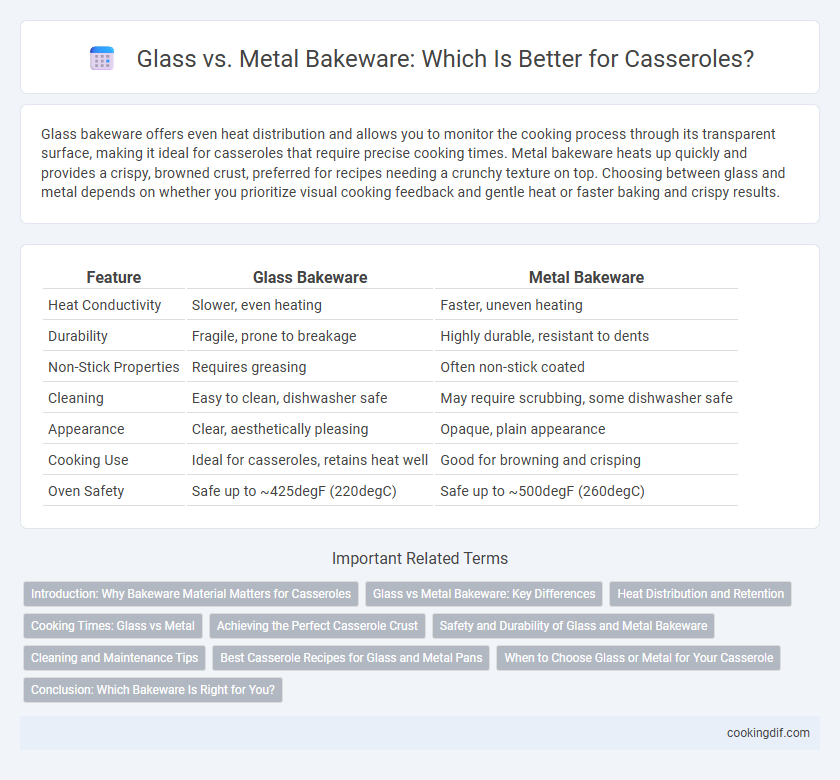Glass bakeware offers even heat distribution and allows you to monitor the cooking process through its transparent surface, making it ideal for casseroles that require precise cooking times. Metal bakeware heats up quickly and provides a crispy, browned crust, preferred for recipes needing a crunchy texture on top. Choosing between glass and metal depends on whether you prioritize visual cooking feedback and gentle heat or faster baking and crispy results.
Table of Comparison
| Feature | Glass Bakeware | Metal Bakeware |
|---|---|---|
| Heat Conductivity | Slower, even heating | Faster, uneven heating |
| Durability | Fragile, prone to breakage | Highly durable, resistant to dents |
| Non-Stick Properties | Requires greasing | Often non-stick coated |
| Cleaning | Easy to clean, dishwasher safe | May require scrubbing, some dishwasher safe |
| Appearance | Clear, aesthetically pleasing | Opaque, plain appearance |
| Cooking Use | Ideal for casseroles, retains heat well | Good for browning and crisping |
| Oven Safety | Safe up to ~425degF (220degC) | Safe up to ~500degF (260degC) |
Introduction: Why Bakeware Material Matters for Casseroles
Glass bakeware offers even heat distribution and allows you to monitor the browning process visually, making it ideal for casseroles that require consistent cooking and attractive presentation. Metal bakeware, particularly aluminum or stainless steel, excels in quick heat conduction and can produce crispier crusts, which enhances texture in baked casseroles. Choosing the right bakeware material impacts cooking time, texture, and flavor development, directly influencing the final quality of your casserole dish.
Glass vs Metal Bakeware: Key Differences
Glass bakeware offers even heat distribution and allows you to monitor the casserole while it cooks, preventing overbaking, whereas metal bakeware heats quickly and promotes browning and crispiness due to higher thermal conductivity. Glass is non-reactive and ideal for acidic dishes, while metal pans, typically aluminum or stainless steel, may react with certain ingredients but provide superior durability and faster cooking times. Choosing between glass and metal bakeware depends on the desired texture, cooking speed, and recipe requirements for your casserole.
Heat Distribution and Retention
Glass bakeware offers even heat distribution and excellent heat retention, allowing casseroles to cook uniformly and stay warm longer after removal from the oven. Metal bakeware heats up quickly and promotes browning due to its high thermal conductivity but may result in hotspots and less consistent cooking. Choosing between glass and metal depends on the desired cooking outcome: glass for steady, even cooking and warmth, metal for faster heat response and crispier textures.
Cooking Times: Glass vs Metal
Glass bakeware typically requires longer cooking times than metal because it heats more slowly and retains heat longer, promoting even cooking and browning. Metal bakeware conducts heat faster, leading to shorter cooking times and crispier edges, making it ideal for recipes requiring quick, intense heat. Adjustments in baking duration and temperature are essential when switching between glass and metal to ensure casseroles cook evenly without overcooking or undercooking.
Achieving the Perfect Casserole Crust
Glass bakeware promotes even heat distribution, resulting in a golden, crispy casserole crust with less risk of burning. Metal bakeware, especially aluminum or stainless steel, heats up faster and provides superior browning and a crunchier crust. Choosing metal for casseroles ensures optimal caramelization, while glass is ideal for slow, uniform cooking without over-browning.
Safety and Durability of Glass and Metal Bakeware
Glass bakeware is non-reactive and resistant to scratches, making it a safe choice for cooking acidic dishes without leaching chemicals, while offering excellent heat retention for even cooking. Metal bakeware, particularly stainless steel and aluminum with non-stick coatings, provides superior durability and faster heating but may react with acidic ingredients if uncoated, potentially affecting food safety. Both materials withstand high oven temperatures, though glass can shatter under rapid temperature changes, whereas metal bakeware is more resistant to warping and impact damage.
Cleaning and Maintenance Tips
Glass bakeware for casseroles offers non-porous surfaces that resist staining and odors, making cleaning straightforward with warm soapy water or a baking soda paste for tougher residues. Metal bakeware, especially non-stick varieties, requires gentle hand washing and avoiding abrasive scrubbers to preserve the coating and prevent rust. Both materials benefit from soaking after use, but glass is generally dishwasher safe, while some metal pans may warp or discolor under high dishwasher temperatures.
Best Casserole Recipes for Glass and Metal Pans
Glass bakeware evenly distributes heat, making it ideal for slow-cooked casseroles that require thorough baking without burning the edges. Metal pans, especially aluminum or stainless steel, heat up quickly and create a crispier, browned crust perfect for recipes like macaroni and cheese or shepherd's pie. Choosing the right bakeware enhances texture and flavor, with glass best for moist, tender bakes and metal preferred for dishes needing a crunchy top layer.
When to Choose Glass or Metal for Your Casserole
Glass bakeware excels in even heat distribution and retaining heat, making it ideal for casseroles that require slow, steady cooking or baking dishes that benefit from visual monitoring. Metal bakeware, with its superior heat conductivity and quick response to temperature changes, is best suited for recipes needing crispy edges or faster cooking times. Choosing between glass and metal depends on the desired texture and cooking speed: use glass for gentle, uniform cooking and metal for browning and speedier results.
Conclusion: Which Bakeware Is Right for You?
Glass bakeware offers even heat distribution and allows you to monitor browning through its transparent sides, making it ideal for casseroles that require consistent cooking and visual checks. Metal bakeware heats up faster and provides superior crisping and browning, perfect for recipes needing a crunchy top layer. Choosing between glass and metal depends on your casserole preferences: glass for gentle, consistent cooking and metal for higher heat and a crispy finish.
Glass vs metal bakeware for casserole Infographic

 cookingdif.com
cookingdif.com